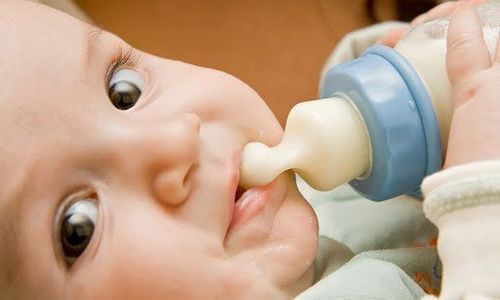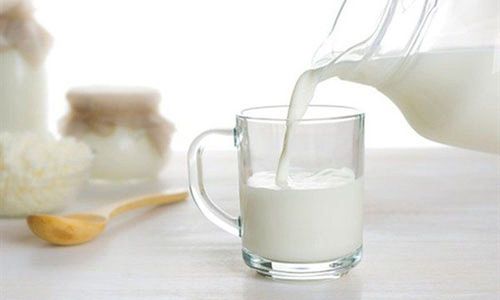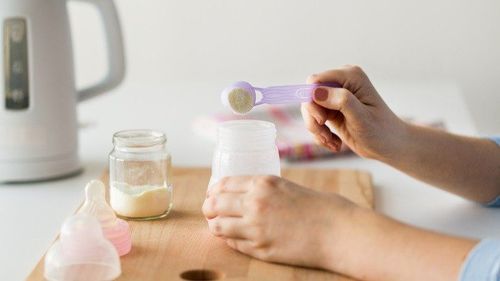This is an automatically translated article.
Breastfeeding mothers may choose to supplement with formula for a variety of reasons. However, if you decide to add formula to your baby, there are a few things to keep in mind before mixing formula with breast milk.
Actually, you can completely mix these two formulas together in the same bottle, but you need to follow the mixing instructions before combining formula with breast milk. Improper mixing can lead to over-concentration of essential nutrients and be dangerous to your baby.
1. Why should you mix breast milk with formula?
Many mothers choose to mix breast milk with formula for a variety of reasons, including:
More rest time: Breastfeeding and formula feeding is a helpful way to help mothers have more time to sleep. This way, mom and dad can take turns breastfeeding at night, giving mom a chance to rest. Ensure nutrition for your baby: Some women may have difficulty providing an adequate supply of breast milk to breastfeed exclusively. Therefore, supplementing with formula can help your baby get more of the nutrients he needs while still breastfeeding. Return to work: Many mothers choose to combine breastfeeding and formula feeding for convenience when returning to work.

Một số trường hợp gặp khó khăn trong việc cung cấp đầy đủ nguồn sữa cho con bú vì vậy cần bổ sung thêm sữa công thức
Whatever the reason, if you decide to give your baby breast milk and formula, you can still mix them in the same bottle for your baby to use.
However, formula feeding can affect the amount of breast milk produced. There is limited evidence that infants may not be interested in breastfeeding because they would rather learn to use a different feeding pattern than a bottle.
These things can make breastfeeding more difficult, especially during the first few weeks when you and your baby are still comfortable with breastfeeding. Your breast milk supply won't be affected if you start bottle-feeding your baby when they're a little older.
2. Formula feed your baby
Before switching to formula feeding, there are a few things you should keep in mind:
You should start this method gradually to give your body time to reduce the amount of milk produced. This helps reduce the risk of breast discomfort, swelling or mastitis. If you want to go back to work, it's a good idea to start formula-feeding a few weeks in advance to give you both time to adjust and acclimate. If your baby is 6 months old or older and can drink from a cup, you don't need to introduce him to bottle milk anymore.
3. How to give your baby a bottle to practice

Tập cho trẻ bú bình không nên lựa chọn vào khoảng thời gian trẻ đang đói.
It can take a long time for a breastfed baby to adjust to bottle feeding as the baby needs to use a different sucking motion at this time. Here are some ways that you can apply when giving your baby a bottle, including:
Practice giving your baby the first few bottles when he is feeling happy and comfortable, but should not choose when the child is hungry. You can ask someone else to give your baby the first bottle so that your baby is not near you and can smell your breast milk. Use a different position for bottle feeding.
4. Safety considerations when mixing breast milk with formula
Infant formula is usually made to give your baby a certain amount of calories and nutrients in a specific amount of milk. For example, the standard recipe is 20 calories per fluid ounce. Therefore, when mixing formula milk, mothers should mix according to the instructions to provide the necessary amount of nutrients for the baby, avoid excess and exceed the prescribed level.
However, if you add powdered formula or concentrated liquid formula directly to breast milk before diluting it with water, it may alter the balance of nutrients and water in the breast milk. both breast milk and infant formula.
In fact, the kidneys of infants and young children are often not fully developed as in adults. Your baby's kidneys will need enough water to be able to process all the nutrients in the food consumed, especially salt and protein. When you give your baby too much food, it can be dangerous and overwhelming for the baby's body because they can't handle it. Therefore, when preparing infant formula, you should always mix it with the correct amount of water and follow all instructions from your healthcare professional recommended.
5. How to mix formula with breast milk

Tuyệt đối không được thêm trực tiếp sữa công thức dạng bột chưa pha loãng hoặc sữa công thức dạng lỏng đậm đặc vào sữa mẹ
When choosing formula for your baby, you often find there are three different types of formula, including: Concentrated liquid formula, powdered and ready-to-drink powder.
Concentrated and powdered liquid formula If you are using concentrated liquid or powdered infant formula, make sure to follow the manufacturer's instructions or any alternative instructions. any from the doctor.
You should mix formula first and separate from breast milk. Powdered and concentrated formula is usually diluted with sterile water or safe drinking water that has been boiled for 5 minutes and then allowed to cool.
In addition, you can also use tap water if the water in your area is of good quality and safe for your baby's health. You should talk to your doctor to find out if tap water could be a safe alternative.
After you have finished making concentrated liquid or powdered formula, you can add them to the breast milk bottle or give it after the breast milk bottle.
Safety Tip You should never add undiluted powdered formula or concentrated liquid formula directly to breast milk. Also, you should not use breast milk in place of water to make concentrated liquid or powdered formula.
If you have any questions or concerns about how to properly dilute/mix formula for your baby, talk to your healthcare professional specifically.
Pre-mixed powdered formula You can absolutely add breast milk to a bottle of pre-mixed powdered formula. This type of formulation is usually not very concentrated (it has been properly diluted), so it should not pose any of the same concerns as products that need to be premixed.
6. Reasons not to mix formula with breast milk

Sữa mẹ chứa nhiều đặc tính dinh dưỡng và tốt cho sức khỏe hơn so với sữa công thức
While you can mix breast milk and pre-mixed formula in the same bottle, there are some good reasons why you shouldn't mix the two, including:
Don't mix Breast milk costs: If you breastfeed first, your baby will not be able to finish. You should let your baby drink all available breast milk before adding formula. Your baby will get all the benefits from breast milk: Since breast milk contains more nutritional and healthful properties than formula, it's still better to give priority to breastfeeding. so that your baby can absorb the most essential nutrients for growth. Children in the period from 6 months to 3 years old are very susceptible to respiratory problems, respiratory infections, skin diseases and gastrointestinal infections... parents need to pay special attention to the care and provision of adequate nutrition for children.
Parents should supplement their children with supportive products containing lysine, essential micro-minerals and vitamins such as zinc, chromium, selenium, and B vitamins to help fully meet their child's nutritional needs. At the same time, these essential vitamins also support digestion, enhance nutrient absorption, help improve anorexia, and help children eat well.
Parents can learn more:
Signs of zinc deficiency in children
Micronutrient deficiency and failure to gain weight in children
Please regularly visit Vinmec.com website and update useful information to take care of your child. Take care of the baby and the whole family.
References: verywellfamily.com, nhs.uk, babycenter.com













